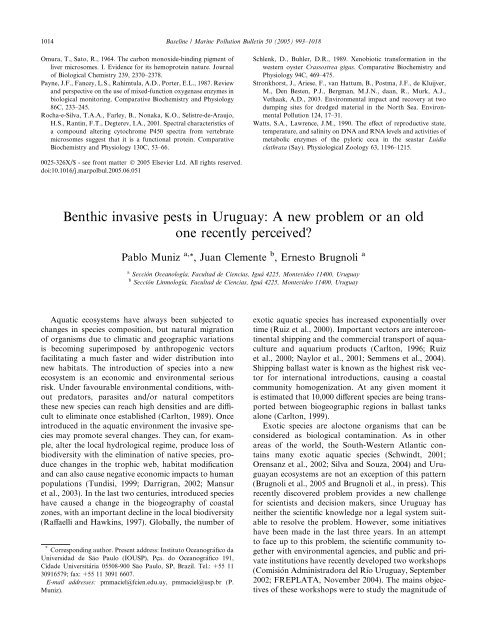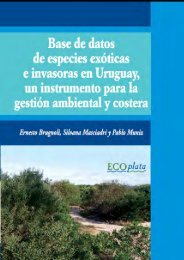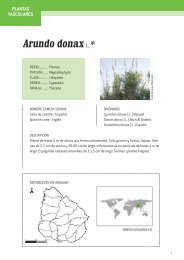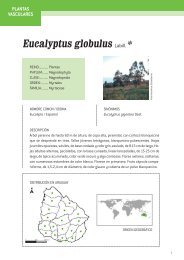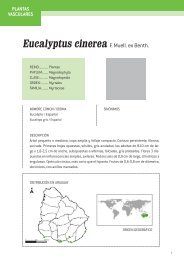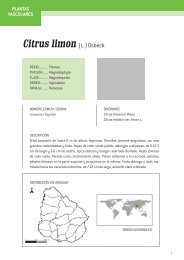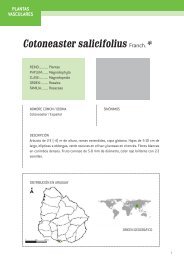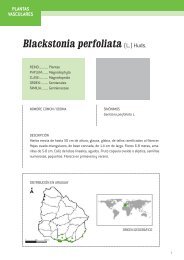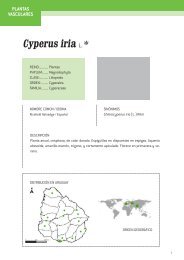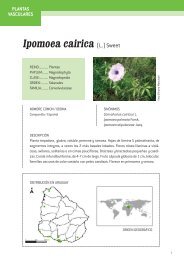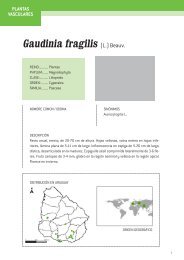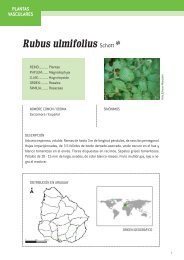Benthic invasive pests in Uruguay - index - Facultad de Ciencias
Benthic invasive pests in Uruguay - index - Facultad de Ciencias
Benthic invasive pests in Uruguay - index - Facultad de Ciencias
Create successful ePaper yourself
Turn your PDF publications into a flip-book with our unique Google optimized e-Paper software.
1014 Basel<strong>in</strong>e / Mar<strong>in</strong>e Pollution Bullet<strong>in</strong> 50 (2005) 993–1018<br />
Omura, T., Sato, R., 1964. The carbon monoxi<strong>de</strong>-b<strong>in</strong>d<strong>in</strong>g pigment of<br />
liver microsomes. I. Evi<strong>de</strong>nce for its hemoprote<strong>in</strong> nature. Journal<br />
of Biological Chemistry 239, 2370–2378.<br />
Payne, J.F., Fancey, L.S., Rahimtula, A.D., Porter, E.L., 1987. Review<br />
and perspective on the use of mixed-function oxygenase enzymes <strong>in</strong><br />
biological monitor<strong>in</strong>g. Comparative Biochemistry and Physiology<br />
86C, 233–245.<br />
Rocha-e-Silva, T.A.A., Farley, B., Nonaka, K.O., Selistre-<strong>de</strong>-Araujo,<br />
H.S., Rant<strong>in</strong>, F.T., Degterev, I.A., 2001. Spectral characteristics of<br />
a compound alter<strong>in</strong>g cytochrome P450 spectra from vertebrate<br />
microsomes suggest that it is a functional prote<strong>in</strong>. Comparative<br />
Biochemistry and Physiology 130C, 53–66.<br />
Schlenk, D., Buhler, D.R., 1989. Xenobiotic transformation <strong>in</strong> the<br />
western oyster Crassostrea gigas. Comparative Biochemistry and<br />
Physiology 94C, 469–475.<br />
Stronkhorst, J., Ariese, F., van Hattum, B., Postma, J.F., <strong>de</strong> Kluijver,<br />
M., Den Besten, P.J., Bergman, M.J.N., daan, R., Murk, A.J.,<br />
Vethaak, A.D., 2003. Environmental impact and recovery at two<br />
dump<strong>in</strong>g sites for dredged material <strong>in</strong> the North Sea. Environmental<br />
Pollution 124, 17–31.<br />
Watts, S.A., Lawrence, J.M., 1990. The effect of reproductive state,<br />
temperature, and sal<strong>in</strong>ity on DNA and RNA levels and activities of<br />
metabolic enzymes of the pyloric ceca <strong>in</strong> the seastar Luidia<br />
clathrata (Say). Physiological Zoology 63, 1196–1215.<br />
0025-326X/$ - see front matter Ó 2005 Elsevier Ltd. All rights reserved.<br />
doi:10.1016/j.marpolbul.2005.06.051<br />
<strong>Benthic</strong> <strong><strong>in</strong>vasive</strong> <strong>pests</strong> <strong>in</strong> <strong>Uruguay</strong>: A new problem or an old<br />
one recently perceived<br />
Pablo Muniz a, *, Juan Clemente b , Ernesto Brugnoli a<br />
a Sección Oceanología, <strong>Facultad</strong> <strong>de</strong> <strong>Ciencias</strong>, Iguá 4225, Montevi<strong>de</strong>o 11400, <strong>Uruguay</strong><br />
b Sección Limnología, <strong>Facultad</strong> <strong>de</strong> <strong>Ciencias</strong>, Iguá 4225, Montevi<strong>de</strong>o 11400, <strong>Uruguay</strong><br />
Aquatic ecosystems have always been subjected to<br />
changes <strong>in</strong> species composition, but natural migration<br />
of organisms due to climatic and geographic variations<br />
is becom<strong>in</strong>g superimposed by anthropogenic vectors<br />
facilitat<strong>in</strong>g a much faster and wi<strong>de</strong>r distribution <strong>in</strong>to<br />
new habitats. The <strong>in</strong>troduction of species <strong>in</strong>to a new<br />
ecosystem is an economic and environmental serious<br />
risk. Un<strong>de</strong>r favourable environmental conditions, without<br />
predators, parasites and/or natural competitors<br />
these new species can reach high <strong>de</strong>nsities and are difficult<br />
to elim<strong>in</strong>ate once established (Carlton, 1989). Once<br />
<strong>in</strong>troduced <strong>in</strong> the aquatic environment the <strong><strong>in</strong>vasive</strong> species<br />
may promote several changes. They can, for example,<br />
alter the local hydrological regime, produce loss of<br />
biodiversity with the elim<strong>in</strong>ation of native species, produce<br />
changes <strong>in</strong> the trophic web, habitat modification<br />
and can also cause negative economic impacts to human<br />
populations (Tundisi, 1999; Darrigran, 2002; Mansur<br />
et al., 2003). In the last two centuries, <strong>in</strong>troduced species<br />
have caused a change <strong>in</strong> the biogeography of coastal<br />
zones, with an important <strong>de</strong>cl<strong>in</strong>e <strong>in</strong> the local biodiversity<br />
(Raffaelli and Hawk<strong>in</strong>s, 1997). Globally, the number of<br />
* Correspond<strong>in</strong>g author. Present address: Instituto Oceanográfico da<br />
Universidad <strong>de</strong> São Paulo (IOUSP), Pça. do Oceanográfico 191,<br />
Cida<strong>de</strong> Universitária 05508-900 São Paulo, SP, Brazil. Tel.: +55 11<br />
30916579; fax: +55 11 3091 6607.<br />
E-mail addresses: pmmaciel@fcien.edu.uy, pmmaciel@usp.br (P.<br />
Muniz).<br />
exotic aquatic species has <strong>in</strong>creased exponentially over<br />
time (Ruiz et al., 2000). Important vectors are <strong>in</strong>tercont<strong>in</strong>ental<br />
shipp<strong>in</strong>g and the commercial transport of aquaculture<br />
and aquarium products (Carlton, 1996; Ruiz<br />
et al., 2000; Naylor et al., 2001; Semmens et al., 2004).<br />
Shipp<strong>in</strong>g ballast water is known as the highest risk vector<br />
for <strong>in</strong>ternational <strong>in</strong>troductions, caus<strong>in</strong>g a coastal<br />
community homogenization. At any given moment it<br />
is estimated that 10,000 different species are be<strong>in</strong>g transported<br />
between biogeographic regions <strong>in</strong> ballast tanks<br />
alone (Carlton, 1999).<br />
Exotic species are aloctone organisms that can be<br />
consi<strong>de</strong>red as biological contam<strong>in</strong>ation. As <strong>in</strong> other<br />
areas of the world, the South-Western Atlantic conta<strong>in</strong>s<br />
many exotic aquatic species (Schw<strong>in</strong>dt, 2001;<br />
Orensanz et al., 2002; Silva and Souza, 2004) and <strong>Uruguay</strong>an<br />
ecosystems are not an exception of this pattern<br />
(Brugnoli et al., 2005 and Brugnoli et al., <strong>in</strong> press). This<br />
recently discovered problem provi<strong>de</strong>s a new challenge<br />
for scientists and <strong>de</strong>cision makers, s<strong>in</strong>ce <strong>Uruguay</strong> has<br />
neither the scientific knowledge nor a legal system suitable<br />
to resolve the problem. However, some <strong>in</strong>itiatives<br />
have been ma<strong>de</strong> <strong>in</strong> the last three years. In an attempt<br />
to face up to this problem, the scientific community together<br />
with environmental agencies, and public and private<br />
<strong>in</strong>stitutions have recently <strong>de</strong>veloped two workshops<br />
(Comisión Adm<strong>in</strong>istradora <strong>de</strong>l Río <strong>Uruguay</strong>, September<br />
2002; FREPLATA, November 2004). The ma<strong>in</strong>s objectives<br />
of these workshops were to study the magnitu<strong>de</strong> of
Basel<strong>in</strong>e / Mar<strong>in</strong>e Pollution Bullet<strong>in</strong> 50 (2005) 993–1018 1015<br />
the <strong>in</strong>vasion processes <strong>in</strong> <strong>Uruguay</strong> and the Argent<strong>in</strong>e,<br />
and to <strong>de</strong>tect those ecosystems that are be<strong>in</strong>g directly<br />
or <strong>in</strong>directly impacted.<br />
In <strong>Uruguay</strong>, more than ten benthic <strong><strong>in</strong>vasive</strong> species<br />
have been reported (Brugnoli et al., <strong>in</strong> press). Two of<br />
them, recently recor<strong>de</strong>d, are of special <strong>in</strong>terest because<br />
of their potential to cause negative ecological and economical<br />
impacts, both <strong>in</strong> coastal and cont<strong>in</strong>ental ecosystems<br />
(Clemente and Brugnoli, 2002; Borthagaray et al.,<br />
<strong>in</strong> press). They are the gol<strong>de</strong>n mussel Limnoperna fortunei<br />
and the reef-build<strong>in</strong>g polychaete Ficopomatus enigmaticus.<br />
In this contribution we briefly summarized<br />
the state of the ecological/biological knowledge concern<strong>in</strong>g<br />
these two benthic <strong>pests</strong>.<br />
Mollusca, Bivalvia, Mytlillidae: Limnoperna fortunei<br />
(Dunker 1857), popularly known as the gol<strong>de</strong>n mussel<br />
is a mytilid <strong><strong>in</strong>vasive</strong> species of the Plata Bas<strong>in</strong>, native<br />
to freshwater systems of Ch<strong>in</strong>a and South-East Asia.<br />
It was <strong>in</strong>troduced acci<strong>de</strong>ntally <strong>in</strong> the region <strong>in</strong> 1991 via<br />
ballast water (Darrigran and Pastor<strong>in</strong>o, 1995). It has<br />
an epifaunal and aggregate behaviour (Cataldo and Boltovskoy,<br />
2000; Darrigran and Ezcurra <strong>de</strong> Drago, 2000)<br />
and occurs <strong>in</strong> fresh and brackish water ecosystems (Darrigran,<br />
2002). It is a dioecious species with external<br />
fecundity and a swimm<strong>in</strong>g larval phase (Darrigran and<br />
Pastor<strong>in</strong>o, 1993; Cataldo and Boltovskoy, 2000). Attached<br />
to hard substrata by means of a byssus, it reaches<br />
high <strong>de</strong>nsities. In <strong>Uruguay</strong> it has been recor<strong>de</strong>d <strong>in</strong> four<br />
of the six ma<strong>in</strong> hydrographical bas<strong>in</strong>s: Río <strong>de</strong> la Plata,<br />
Santa Lucía, Negro and <strong>Uruguay</strong> Rivers (Fig. 1, Scarab<strong>in</strong>o<br />
and Ver<strong>de</strong>, 1995; Darrigran and Ezcurra <strong>de</strong> Drago,<br />
2000; Brugnoli et al., 2005). In the Merín Lagoon and<br />
Atlantic Bas<strong>in</strong>s there are no records of this mussel,<br />
although Brugnoli et al. (2005) suggests that its access<br />
to both bas<strong>in</strong>s could had been possible throughout the<br />
San Gonzalo channel which connects Los Patos and<br />
Merín Lagoon systems.<br />
Previous studies have <strong>de</strong>monstrated that the <strong>in</strong>faunal<br />
bivalves of the region, composed of Etherioi<strong>de</strong>a and<br />
Corbiculidae, may be dramatically affected by Limnoperna<br />
fortunei (Orensanz et al., 2002; Mansur et al.,<br />
2003; Scarab<strong>in</strong>o, 2004). The species richness and abundance<br />
of Hirud<strong>in</strong>ea and Oligochaeta <strong>in</strong>creased while<br />
Gastropoda <strong>de</strong>creased <strong>in</strong> communities <strong>in</strong>habit<strong>in</strong>g the<br />
benthic fauna of the Argent<strong>in</strong>ean coast of the Río <strong>de</strong><br />
la Plata estuary (Darrigran et al., 1998). Brugnoli et al.<br />
(2005) found changes <strong>in</strong> the relative abundances of the<br />
ma<strong>in</strong> groups of the zooplankton (Crustacea and Rotifera)<br />
caused by the presence of the Limnoperna fortunei<br />
larvae, with potential modifications <strong>in</strong> the trophic web<br />
at the Palmar reservoir (Negro River). Recently, Sylvester<br />
et al. (2005) reported that the high filtration rates<br />
associated with high <strong>de</strong>nsities of the gol<strong>de</strong>n mussel <strong>in</strong><br />
the Paraná watershed may swiftly change the ecological<br />
conditions <strong>in</strong> the colonised areas.<br />
Due to its high <strong>de</strong>nsities, Limnoperna fortunei has<br />
rapidly become a major nuisance for <strong>in</strong>dustrial and<br />
power plants along the Paraná-Paraguay, <strong>Uruguay</strong><br />
and Río <strong>de</strong> la Plata that use raw river water (Darrigran,<br />
2002; Cataldo et al., 2003). Limnoperna is a foul<strong>in</strong>g bivalve<br />
caus<strong>in</strong>g filter obstructions, damage <strong>in</strong> the cool<strong>in</strong>g<br />
systems and/or obstruction of the system pipes. In <strong>Uruguay</strong>,<br />
some problems associated with high <strong>de</strong>nsities of L.<br />
fortunei has been recor<strong>de</strong>d, especially those related to<br />
water supply systems and hydroelectric power plants<br />
(Fig. 2) (Clemente and Brugnoli, 2002), and <strong>in</strong> several<br />
other <strong>in</strong>dustrial activities, which use water for refrigeration<br />
(Irurueta et al., 2003). Reservoirs, navigation locks,<br />
Fig. 1. Map of <strong>Uruguay</strong> show<strong>in</strong>g the locations were Limnoperna fortunei (a, b, c and d) and Ficopomatus enigmaticus (e, f, g and h) have been<br />
recor<strong>de</strong>d. a = Salto Gran<strong>de</strong> reservoir at <strong>Uruguay</strong> River; b = Santa Lucia River; c = Palmar hydroelectric power plant at Negro River (UTE); d = Yí<br />
River; e = Oil petroleum ref<strong>in</strong>ery <strong>in</strong> Montevi<strong>de</strong>o (ANCAP); f = Pando River; g = Solís Gran<strong>de</strong> Stream estuary and h = Rocha coastal lagoon.
1016 Basel<strong>in</strong>e / Mar<strong>in</strong>e Pollution Bullet<strong>in</strong> 50 (2005) 993–1018<br />
Fig. 2. Limnoperna fortunei (a) attached to hard substrata <strong>in</strong> the<br />
littoral zone of the Palmar reservoir dur<strong>in</strong>g low water level; and (b)<br />
macro-foul<strong>in</strong>g <strong>in</strong>to the water distribution systems of Palmar hydroelectric<br />
power plant. Photograph credits: E. Brugnoli. Scale:<br />
1 cm = 25 cm.<br />
and other artificial structures can also become <strong>in</strong>tensely<br />
fouled. These problems generate <strong>in</strong>direct costs due to an<br />
<strong>in</strong>crease <strong>in</strong> the frequency of clean-up, equipment repair<br />
and for pest removal. Although this problem was recently<br />
discovered, it has been estimated that around<br />
US$ 70,000 has been spent <strong>in</strong> the last three years <strong>in</strong> <strong>Uruguay</strong><br />
(Brugnoli et al., <strong>in</strong> press).<br />
Annelida, Polychaeta, Serpulidae: Ficopomatus enigmaticus<br />
(Fauvel 1923) is an exotic reef-build<strong>in</strong>g polychaete<br />
distributed <strong>in</strong> most brackish waters <strong>in</strong><br />
temperate zones throughout the world (Ten Hove and<br />
Weer<strong>de</strong>nburg, 1978). As a species produc<strong>in</strong>g habitat creation<br />
and modification, is it known as an ‘‘ecosystem<br />
eng<strong>in</strong>eer’’ (Schw<strong>in</strong>dt et al., 2004a). Their calcareous<br />
reefs can produce large extensions <strong>in</strong> shallow water<br />
and low energy environments. These reefs can act as efficient<br />
traps for sediments, generat<strong>in</strong>g topographic heterogeneity<br />
that promote changes <strong>in</strong> the abundance and<br />
distribution of the benthic associated communities (Schw<strong>in</strong>dt<br />
and Iribarne, 2000). The trochophore larvae, once<br />
settled <strong>in</strong> hard substrata, form a calcareous tube that is<br />
secreted by the collar glands (Obenat and Pezzani,<br />
1994). This species orig<strong>in</strong>ates <strong>in</strong> Australia (Allen,<br />
1953), and <strong>in</strong> 1970 colonised Mar Chiquita lagoon <strong>in</strong><br />
Argent<strong>in</strong>a (Orensanz and Estivariz, 1971). Tube size<br />
and shape varies accord<strong>in</strong>g to environmental variables,<br />
but <strong>in</strong> general the reefs are circular structures that can<br />
reach 2.5 m <strong>in</strong> diameter and grow a rate estimated to<br />
be 1.6 cm/month (Schw<strong>in</strong>dt et al., 2004b). In Mar Chiquita<br />
lagoon, where the species has been well studied for<br />
20 years, reef cover is presently much higher than <strong>in</strong> the<br />
past and reefs of similar size coalesce to form platforms<br />
several metres long (Schw<strong>in</strong>dt et al., 2004b).<br />
In <strong>Uruguay</strong>, Ficopomatus has been recor<strong>de</strong>d <strong>in</strong> the<br />
Pando Stream and Castillos coastal lagoon (Nión,<br />
1979), <strong>in</strong> the most <strong>in</strong>ner region of the Solís Gran<strong>de</strong><br />
Stream estuary (Muniz and Ventur<strong>in</strong>i, 2001; Fig. 3)<br />
and more recently <strong>in</strong> the Rocha coastal lagoon (Fig. 1)<br />
(Borthagaray et al., <strong>in</strong> press). In the Solís Gran<strong>de</strong><br />
Stream estuary the reefs are of small size (approx.<br />
20 cm) and are generally attached to <strong>de</strong>ad and live<br />
valves of the native mollusc Tagelus plebeius (Muniz<br />
and Ventur<strong>in</strong>i, 2001). The species has a negative effect,<br />
mak<strong>in</strong>g the benthic community health classified as heavily<br />
perturbed (Muniz et al., 2005). In the Rocha lagoon,<br />
the species is present only <strong>in</strong> the shallow <strong>in</strong>nermost region,<br />
where the concentration of suspen<strong>de</strong>d matter is<br />
high and the current speed low (Con<strong>de</strong> et al., 1999;<br />
Borthagaray et al., <strong>in</strong> press).<br />
Ficopomatus enigmaticus also causes negative economic<br />
impacts <strong>in</strong> <strong>Uruguay</strong> (Brugnoli et al., <strong>in</strong> press). Recently,<br />
large tubes (twice <strong>in</strong> size to those found <strong>in</strong><br />
natural environments) were recor<strong>de</strong>d obstruct<strong>in</strong>g the<br />
cool<strong>in</strong>g system of the <strong>Uruguay</strong>an oil ref<strong>in</strong>ery (ANCAP,<br />
Fig. 3). The species has not been recor<strong>de</strong>d <strong>in</strong> the waters<br />
of Montevi<strong>de</strong>o Bay (Muniz et al., 2000; Ventur<strong>in</strong>i et al.,<br />
2004), but were found several years ago <strong>in</strong> the mouth of<br />
Pantanoso stream (Scarab<strong>in</strong>o et al., 1975) near where<br />
the oil ref<strong>in</strong>ery is <strong>in</strong>stalled. How the species reached<br />
the ANCAP <strong>in</strong>stallation is a question that can not be answered<br />
with the present knowledge.<br />
Inva<strong>de</strong>r species are often one of the ma<strong>in</strong> factors <strong>in</strong><br />
ecological <strong>de</strong>gradation (Ricciardi and Atk<strong>in</strong>son, 2004).<br />
Therefore, is necessary to establish national and <strong>in</strong>ternational<br />
research programmes to m<strong>in</strong>imise the impacts of<br />
the exotic species, and to <strong>de</strong>velop mo<strong>de</strong>ls to predict the<br />
<strong>in</strong>troduction of new <strong>in</strong>va<strong>de</strong>rs. It is clear that once established<br />
<strong>in</strong> a new environment, the eradication of exotic<br />
species is very difficult. Thus, <strong>in</strong> an attempt to solve this<br />
problem, which was recently discovered <strong>in</strong> <strong>Uruguay</strong>, we<br />
propose a simple assessment of potential recipient regions,<br />
which could be generated accord<strong>in</strong>g to three simple<br />
steps: (i) i<strong>de</strong>ntification of all possible exotic species whose<br />
<strong>in</strong>troduction and dispersion should be avoi<strong>de</strong>d, as well as<br />
the assessment of the ecological and economic costs of<br />
their possible <strong>in</strong>troduction; (ii) i<strong>de</strong>ntification of the dispersion<br />
vectors (us<strong>in</strong>g for example patterns of recent<br />
<strong>in</strong>vasions <strong>in</strong> other parts of the world); and (iii) assessment<br />
of the ma<strong>in</strong> environmental parameters of the recipient<br />
ecosystems and of those that present risk of <strong>in</strong>vasion.<br />
F<strong>in</strong>ally, with knowledge of the distribution, ecology,<br />
life history and impacts of alien species, both <strong>in</strong> a
Basel<strong>in</strong>e / Mar<strong>in</strong>e Pollution Bullet<strong>in</strong> 50 (2005) 993–1018 1017<br />
Fig. 3. Ficopomatus enigmaticus collected (a) <strong>in</strong> the northern portion of Solís Gran<strong>de</strong> stream estuary and (b) and (c) <strong>in</strong> the cool<strong>in</strong>g system of the<br />
ANCAP petroleum ref<strong>in</strong>ery (Montevi<strong>de</strong>o, <strong>Uruguay</strong>) Photograph credits: J. Clemente for (a) and R. Russo for (b) and (c). Scale: <strong>in</strong> (a) 1 cm = 5 cm;<br />
(b) 1 cm = 15 cm and (c) 1 cm = 20 cm.<br />
national and <strong>in</strong> a regional scale, it would be possible to<br />
improve management and control. S<strong>in</strong>ce shipp<strong>in</strong>g traffic<br />
appears to be the most important <strong>in</strong>troduction vector,<br />
we emphasize the need for effective controls on ballastwater<br />
discharge <strong>in</strong> harbours of the region. The prevention<br />
of such a problem is always easier, less expensive<br />
and more effective than eradication.<br />
Acknowledgements<br />
Special thanks to the Institute for Global Change<br />
(IAI) through the SACC-CRN Project, for partial support<br />
for the first author. Thanks to L.Boccardi for the<br />
collaboration, R.Russo (Oil ref<strong>in</strong>ery ANCAP), and several<br />
colleagues of electric company (UTE) are also<br />
acknowledged for their contribution <strong>in</strong> different stages<br />
of the work and for some photos of Limnoperna. F<strong>in</strong>ally,<br />
we wish to thank N. Ventur<strong>in</strong>i for k<strong>in</strong>dly review<strong>in</strong>g<br />
the English version of this paper and to the reviewers<br />
for their critical comments that improve the manuscript.<br />
References<br />
Allen, F.E., 1953. Distribution of mar<strong>in</strong>e <strong>in</strong>vertebrates by ships.<br />
Australian Journal of Mar<strong>in</strong>e and Freshwater Research 4, 307–316.<br />
Borthagaray, A., Clemente, J., Boccardi, L., Brugnoli, E., Muniz, P.<br />
Evaluación <strong>de</strong> riesgo <strong>de</strong> <strong>in</strong>vasión <strong>de</strong>Ficopomatus enigmaticus en la<br />
laguna <strong>de</strong> Rocha. In: Con<strong>de</strong>, D., Rodríguez, L., Fagetti, C.,<br />
Vitancurt, J. (Eds.), Avances científico-técnicos para el manejo <strong>de</strong>l<br />
Área Protegida Laguna <strong>de</strong> Rocha. PCLC, CSIC-U<strong>de</strong>laR, Montevi<strong>de</strong>o,<br />
<strong>in</strong> press.<br />
Brugnoli, E., Clemente, J., Boccardi, L., Borthagaray, A., Scarab<strong>in</strong>o,<br />
F., 2005. Gol<strong>de</strong>n mussel Limnoperna fortunei (Bivalvia: Mytilidae)<br />
distribution <strong>in</strong> the ma<strong>in</strong> hydrographical bas<strong>in</strong>s of <strong>Uruguay</strong>: update<br />
and predictions. Anais da Aca<strong>de</strong>mia Brasileira <strong>de</strong> Ciências 77, 235–<br />
244.<br />
Brugnoli, E., Clemente, J., Riestra, G., Boccardi, L., Borthagaray, A.<br />
Especies acuáticas exóticas en <strong>Uruguay</strong>: situación, problemática y<br />
gestión. In: Menafra, R., Rodríguez, L., Scarab<strong>in</strong>o, F., Con<strong>de</strong>, D.<br />
(Eds.), Bases para la conservación y manejo <strong>de</strong> la costa uruguaya.<br />
Vida Silvestre, Montevi<strong>de</strong>o, <strong>in</strong> press.<br />
Carlton, J.T., 1989. ManÕs role <strong>in</strong> chang<strong>in</strong>g the face of the ocean:<br />
biological <strong>in</strong>vasions and implications for conservation of nearshore<br />
environments. Conservation Biology 3, 265–273.<br />
Carlton, J.T., 1996. Pattern, process, and prediction <strong>in</strong> mar<strong>in</strong>e <strong>in</strong>vasion<br />
ecology. Biological Conservation 78, 97–106.<br />
Carlton, J.T., 1999. The scale and ecological consequences of<br />
biological <strong>in</strong>vasions <strong>in</strong> the worldÕs ocean. In: Sandlund, O.T.,<br />
Schei, P.J., Viken, A. (Eds.), Invasive Species and Biodiversity<br />
Management. Kluwer Aca<strong>de</strong>mic Publishers, Dordrecht, pp. 195–<br />
212.<br />
Cataldo, D.H., Boltovskoy, D., 2000. Yearly reproductive activity of<br />
Limnoperna fortunei (Bivalvia) as <strong>in</strong>ferred from the occurrence of<br />
its larvae <strong>in</strong> the plankton of the lower Paraná river and the Río <strong>de</strong><br />
la Plata estuary (Argent<strong>in</strong>a). Aquatic Ecology 34, 307–317.
1018 Basel<strong>in</strong>e / Mar<strong>in</strong>e Pollution Bullet<strong>in</strong> 50 (2005) 993–1018<br />
Cataldo, D.H., Boltovskoy, D., Pose, M., 2003. Toxicity of chlor<strong>in</strong>e<br />
and three nonoxidiz<strong>in</strong>g molluscici<strong>de</strong>s to the pest mussel Limnoperna<br />
fortunei. Journal Awwa 95, 66–78.<br />
Clemente, J., Brugnoli, E., 2002. First record of Limnoperna fortunei<br />
(Dunker 1857) (Bivalvia: Mytilidae) <strong>in</strong> cont<strong>in</strong>ental waters of<br />
<strong>Uruguay</strong> (Río Negro and Río Yi). Boletín <strong>de</strong> la Sociedad<br />
Zoológica <strong>de</strong>l <strong>Uruguay</strong> 13, 29–33.<br />
Con<strong>de</strong>, D., Bonilla, S., Aubriot, R., <strong>de</strong> León, R., P<strong>in</strong>tos, W., 1999.<br />
Comparison of the areal amount of chlorophyll a of planktonic<br />
and attached microalgae <strong>in</strong> a shallow coastal lagoon. Hydrobiologia<br />
408/409, 285–291.<br />
Darrigran, G., 2002. Potential impact of filter-feed<strong>in</strong>g <strong>in</strong>va<strong>de</strong>rs on<br />
temperate <strong>in</strong>land freshwater environments. Biological Invasions 4,<br />
145–156.<br />
Darrigran, G., Ezcurra <strong>de</strong> Drago, I., 2000. Invasion of the exotic<br />
freshwater mussel Limnoperna fortunei (Dunker 1857) (Bivalvia:<br />
Mytilidae) <strong>in</strong> South America. The Nautilus 114, 69–73.<br />
Darrigran, G., Pastor<strong>in</strong>o, G., 1993. Bivalvos <strong>in</strong>vasores en el Río <strong>de</strong>la<br />
Plata, Argent<strong>in</strong>a. Comunicaciones <strong>de</strong> la Sociedad malacológica 64–<br />
65, 309–313.<br />
Darrigran, G., Pastor<strong>in</strong>o, G., 1995. The recent <strong>in</strong>troduction of a<br />
freshwater Asiatic bivalve, Limnoperna fortunei (Mytilidae) <strong>in</strong>to<br />
South America. The Veliger 38, 171–175.<br />
Darrigran, G., Martín, S.M., Gullo, B., Armendáriz, I., 1998.<br />
Macro<strong>in</strong>vertebrates associated with Limnoperna fortunei (Dunker<br />
1857) (Bivalvia: Mytilidae) <strong>in</strong> Río <strong>de</strong> la Plata, Argent<strong>in</strong>a. Hydrobiologia<br />
367, 223–230.<br />
Irurueta, M., Damborenea, C., Darrigran, G., 2003. Variación <strong>de</strong>la<br />
<strong>de</strong>nsidad larvaria <strong>de</strong>l mejillón dorado (Limnoperna fortunei)<br />
(Bivalvia: Mytilidae) en el Río <strong>Uruguay</strong>, balneario Las Cañas.<br />
In: Proceed<strong>in</strong>gs of VII Jornadas <strong>de</strong> Zoología & I Encuentro <strong>de</strong><br />
Ecología <strong>de</strong>l <strong>Uruguay</strong>, Montevi<strong>de</strong>o, <strong>Uruguay</strong>, p. 117.<br />
Mansur, M.C., P<strong>in</strong>heiro dos Santos, C., Darrigran, G., Hydrich, I.,<br />
Calli, C., Rossoni Cardoso, F., 2003. Primeiros datos quailquantitativos<br />
do mexilhão dourado Lilmnoperna fortunei (Dunker),<br />
no <strong>de</strong>lta do Jucuí, no Lago Guaíba e na Laguna dos Patos, Rio<br />
Gran<strong>de</strong> do Sul, Brasil e alguns aspectos <strong>de</strong> sua <strong>in</strong>vasão no novo<br />
ambiente. Revista Brasileira <strong>de</strong> Zoologia 20, 75–84.<br />
Muniz, P., Ventur<strong>in</strong>i, N., 2001. Spatial distribution of the macrozoobenthos<br />
<strong>in</strong> the Solís Gran<strong>de</strong> Stream estuary (Canelones-Maldonado,<br />
<strong>Uruguay</strong>). Brazilian Journal of Biology 61, 409–420.<br />
Muniz, P., Ventur<strong>in</strong>i, N., Rodríguez, M., Martínez, A., Lacerot, G.,<br />
Gómez, M., 2000. <strong>Benthic</strong> communities <strong>in</strong> a highly polluted urban<br />
bay. p: 204–207. In: Milón, P.J., Delgado, C.T., Pare<strong>de</strong>s, L.V.,<br />
Pare<strong>de</strong>s, A.O., Benavi<strong>de</strong>s, F.V. (Eds.), Ecología y Desarrollo<br />
Sostenible: Reto <strong>de</strong> América Lat<strong>in</strong>a para el tercer Milenio.<br />
Arequipa, Perú, p. 274.<br />
Muniz, P., Ventur<strong>in</strong>i, N., Pires-Van<strong>in</strong>, A.M.S., Tommasi, L.R., Borja,<br />
A., 2005. Test<strong>in</strong>g the applicability of a Mar<strong>in</strong>e Biotic In<strong>de</strong>x<br />
(AMBI) to assess<strong>in</strong>g the ecological quality of soft-bottom benthic<br />
communities, <strong>in</strong> the South America Atlantic region. Mar<strong>in</strong>e<br />
Pollution Bullet<strong>in</strong> 50, 624–637.<br />
Naylor, R.L., Williams, S.L., Strong, D.R., 2001. Aquaculture––a<br />
gateway for exotic species. Science 294, 1655–1656.<br />
Nión, H., 1979. Zonación <strong>de</strong>l Macrobentos en un sistema lacunar<br />
litoral oceánico. Sem<strong>in</strong>ario sobre Ecología Bentónicas y Sedimentación<br />
<strong>de</strong> la Plataforma Cont<strong>in</strong>ental <strong>de</strong>l Atlántico Sur (Montevi<strong>de</strong>o,<br />
<strong>Uruguay</strong>). Memoria 1, 225–235, UNESCO.<br />
Obenat, S.M., Pezzani, E.E., 1994. Life cycle and population structure<br />
of the polychaete Ficopomatus enigmaticus (Serpulidae) <strong>in</strong> Mar<br />
Chiquita coastal lagoon, Argent<strong>in</strong>a. Estuaries 17, 263–270.<br />
Orensanz, J.M., Estivariz, M.C., 1971. Los anelidos poliquetos <strong>de</strong><br />
aguas salobres <strong>de</strong> la Prov<strong>in</strong>cia <strong>de</strong> Buenos Aires. Revista <strong>de</strong>l Museo<br />
La Plata, Universidad Nacional <strong>de</strong> La Plata XI, pp. 95–112.<br />
Orensanz, J.M., Bortolus, A., Casas, G., Darrigran, G., Elías, R.,<br />
López-Gappa, J.J., Obenat, S., Pascual, M., Pastor<strong>in</strong>o, G.,<br />
Penchasza<strong>de</strong>h, P., Piriz, M.L., Scarab<strong>in</strong>o, F., Schw<strong>in</strong>dt, E., Spivak,<br />
E.D., Villar<strong>in</strong>o, E.A., 2002. No longer the prist<strong>in</strong>e conf<strong>in</strong>es of the<br />
world ocean: a survey of exotic mar<strong>in</strong>e species <strong>in</strong> the South-<br />
Western Atlantic. Biological Invasions 4, 115–143.<br />
Raffaelli, D., Hawk<strong>in</strong>s, S., 1997. Intertidial ecology. Chapman & Hall,<br />
London.<br />
Ricciardi, A., Atk<strong>in</strong>son, S.K., 2004. Dist<strong>in</strong>ctiveness magnifies the<br />
impact of biological <strong>in</strong>va<strong>de</strong>rs <strong>in</strong> aquatic ecosystems. Ecology<br />
Letters 7, 781–784.<br />
Ruiz, G.M., Fofonoff, P.W., Carlton, J.T., Wonham, M.J., H<strong>in</strong>es, A.,<br />
2000. Invasion of coastal mar<strong>in</strong>e communities <strong>in</strong> North America:<br />
apparent patterns, processes and biases. Annual Review of Ecology<br />
and Systematics 31, 481–531.<br />
Scarab<strong>in</strong>o, F., 2004. Conservación <strong>de</strong> la malacofauna uruguaya.<br />
Comunicaciones <strong>de</strong> la Sociedad Malacológica <strong>de</strong>l <strong>Uruguay</strong> 8, 82–<br />
83.<br />
Scarab<strong>in</strong>o, F., Ver<strong>de</strong>, M., 1995. Limnoperna fortunei (Dunker1857) en<br />
la costa uruguaya <strong>de</strong>l Río <strong>de</strong> la Plata (Bivalvia: Mytilidae).<br />
Comunicaciones <strong>de</strong> la Sociedad Malacológica <strong>de</strong>l <strong>Uruguay</strong> 7, 374–<br />
375.<br />
Scarab<strong>in</strong>o, V., Maytía, S., Cachés, M., 1975. Carta bionómica litoral<br />
<strong>de</strong>l Departamento <strong>de</strong> Montevi<strong>de</strong>o I. Niveles superiores <strong>de</strong>l sistema<br />
litoral. Comunicaciones <strong>de</strong> la Sociedad Malacológica <strong>de</strong>l <strong>Uruguay</strong><br />
4, 117–126.<br />
Schw<strong>in</strong>dt, E., 2001. Impacto <strong>de</strong> un poliqueto exótico y formador <strong>de</strong><br />
arrecifes. In: Iribarne, O.O. (Ed.), Reserva <strong>de</strong> Biosfera Mar<br />
Chiquita: Características físicas, biológicas y ecológicas. Editorial<br />
Mart<strong>in</strong>, Mar <strong>de</strong>l Plata, Argent<strong>in</strong>a, pp. 109–113.<br />
Schw<strong>in</strong>dt, E., Iribarne, O.O., 2000. Settlement sites, survival and effects<br />
on benthos of an <strong>in</strong>troduced reef-build<strong>in</strong>g polychaete <strong>in</strong> a SW<br />
Atlantic coastal lagoon. Bullet<strong>in</strong> of Mar<strong>in</strong>e Science 67, 73–82.<br />
Schw<strong>in</strong>dt, E., Iribarne, O.O., Isla, F.I., 2004a. Physical effects of an<br />
<strong>in</strong>vad<strong>in</strong>g reef-build<strong>in</strong>g polychaete on an Argent<strong>in</strong>ean estuar<strong>in</strong>e<br />
environment. Estuar<strong>in</strong>e, Coastal and Shelf Science 59, 109–<br />
120.<br />
Schw<strong>in</strong>dt, E., <strong>de</strong> Francesco, C.G., Iribarne, O.O., 2004b. Individual<br />
and reef growth of the <strong><strong>in</strong>vasive</strong> reef-build<strong>in</strong>g polychaete Ficopomatus<br />
enigmaticus <strong>in</strong> a South-Western Atlantic coastal lagoon.<br />
Jounal of the Mar<strong>in</strong>e Biological Association of the UK 84, 987–<br />
993.<br />
Semmens, B.X., Buhle, E.R., Salomon, A.K., Pattengill-Semmens,<br />
C.V., 2004. A hotspot of non-native mar<strong>in</strong>e fishes: evi<strong>de</strong>nce for the<br />
aquarium tra<strong>de</strong> as <strong>in</strong>vasion pathway. Mar<strong>in</strong>e Ecology Progress<br />
Series 266, 239–244.<br />
da Silva, J.S.V., <strong>de</strong> Souza, R.C.C.L., 2004. Água <strong>de</strong> lastro e<br />
bio<strong>in</strong>vasão. Editora Interciência, Rio <strong>de</strong> Janeiro, Brazil.<br />
Sylvester, F., Dorado, J., Boltovskoy, D., Juárez, A., Cataldo, D.,<br />
2005. Filtration rates of the <strong><strong>in</strong>vasive</strong> pest bivalve Limnoperna<br />
fortunei as a function of size and temperature. Hydrobiologia 534,<br />
71–80.<br />
ten Hove, H.A., Weer<strong>de</strong>nburg, C.A., 1978. A generic revision of the<br />
brackish-water serpulid Ficopomatus ern 1921 (Polychaeta: Serpulidae),<br />
<strong>in</strong>clud<strong>in</strong>g Mercierella Fauvel 1923, Sphaeropomatus Treadwell<br />
1934, Mercierellopsis Rioja 1954, and Neopomatus Pillai<br />
1960. Biological Bullet<strong>in</strong> 154, 96–120.<br />
Tundisi, J.G., 1999. Limnologia no século XXI: Perspectivas e<br />
Desafios. International Institute of Ecology (IIE), São Carlos,<br />
Brazil, 24 p.<br />
Ventur<strong>in</strong>i, N., Muniz, P., Rodriguez, M., 2004. Macrobenthic subtidal<br />
communities <strong>in</strong> relation to sediment pollution: the phylum-level<br />
meta-analysis approach <strong>in</strong> a South-Eastern coastal region of South<br />
America. Mar<strong>in</strong>e Biology 14, 119–126.<br />
0025-326X/$ - see front matter Ó 2005 Elsevier Ltd. All rights reserved.<br />
doi:10.1016/j.marpolbul.2005.06.049


